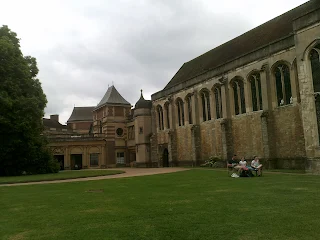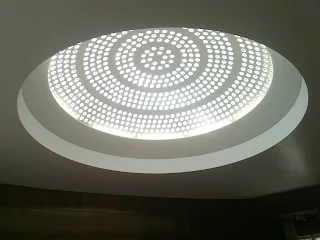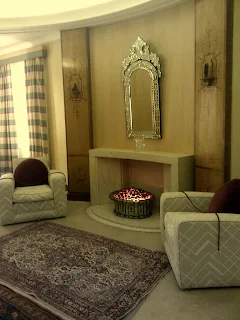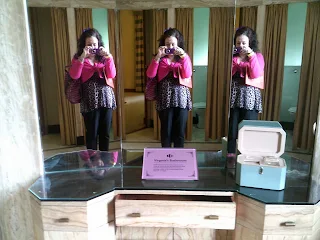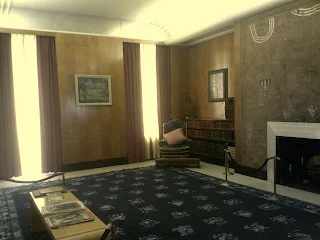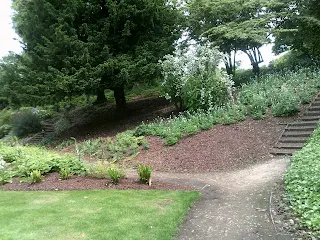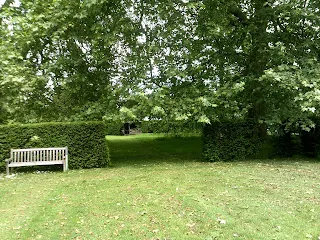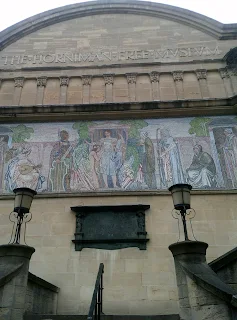Eltham Palace is in south London and was once an important medieval palace. Initially a manor house, it was given to Edward II (r.1307-27) but it was Edward IV (r.1461-83) who made significant changes- notably the addition of the great hall, which still stands today. Subsequent monarchs used the palace as it was only one of six large enough to accommodate and feed the entire court of 800 or so people. Henry VIII (r.1509-47) began to favour Hampton Court and his daughter, Elizabeth I (r.1558-1603) visited only occasionally. Charles I (r.1625-1649) was the last king to visit and then the palace gradually fell into a state of disrepair.
In 1933, Stephen Courtauld (of the fabric dynasty) and his wife Virginia 'Ginie' Peirano, the daughter of a Hungarian mother and an Italian father, took on a 99 year lease from the crown and developed- amid controversy- an Art Deco home whilst retaining as much as possible of the palace remains. The result is the startling building we see today.
Stephen (1883-1967) and Virginia (1881?- 1972) were in their forties when they married and remained childless. Despite being disparate in temperament- he was quiet and introspective whilst she was vivacious and impulsive- their marriage was a success and they entertained in style and supported the arts.
Virginia was unconventional. She had a tattoo of a snake just above her ankle (when I had a rose inked onto my shoulder blade, in 1990, tattoos were still considered risque!) and kept a pet lemur, who was allowed the freedom of the house.
This 1934 painting is of the couple at their home in Grosvenor Square, London, and is by Leonard Campbell Taylor. It is presumed that Stephen is holding the plans for the rebuilding of Eltham Palace. The lemur was called Mah-Jongg, or Jonggy (pronounced Johnny). More about him later!
A piece of useless information- I once designed a dress exactly the same as that in my first role, in 1998. It came in black and red and unfortunately I can't remember which retailer bought it.
The palace was not particularly difficult for me to get to from east London, and quite cheap too. It costs a reasonable £15 to enter BUT the guys on the door need to lose the hard-sell with regard to getting people to subscribe to English Heritage. Here is my pictorial account of the day.
You enter via this bridge...
This is a picturesque view from the bridge, taking in the moat...
A part of the old wall...
Outside the Great Hall...
The Art Deco exterior...
Although the entrance hall is 1930s, to me this looked more late 1960s/ early 1970s and very James Bond- one expected Blofeld to come down the stairs, stroking his cat! Mind you, it was acknowledged that the 1970s was a period where Art Deco post-modernism was in fashion.
I stood on the stairs to take this photograph.
Blofed and his pussycat!
Although this room is triangular, the design gives it the appearance of being round.
The domed skylight. The interior design of this room was created by a Swede, Rolf Engstromer.
Time for cocktails- don't mind if I do!
Their are two sets of stairs and this is one of them...
This is the Venetian Suite, laid out for a video show. I didn't stop to ponder as I wanted to get on...
Vain old tart in the mirror...
The attached bathroom. Bathrooms seem to interest me the most- maybe it's the intimacy of them. Or maybe I'm just too lavatorial.
Here is the bidet. I've never used one of these. I find that soap and a flannel does a good enough job!
Vain old tart being arty. For your info, I'm not wearing the sparkly pink shrug that I always seem to be wearing in photos- this is a non sparkly version!
I liked this hallway bust...
...And this corner cabinet...
...And this recessed statue...
The Pear Room is next to the Venetian Suite. It was used as a guest room.
It's vain old tart time...
This bathroom (if my memory serves me correctly) was found off the hallway. I have to say, it reminded me of an institution.
Vain old tart yet again...
And now we move on to Virginia Courtauld's Bedroom, which is really WOW!
Me in the mirror and I'm loving my coiff...
Next door, we have the bathroom. I heard one guest remark that the bath was, 'Like David Beckham's...' How she would know, I don't know. But I loved this ostentatious delight!
Behind a curtain, we find Virginia's khazi...
Her sink...
Her dressing table and V.O.T. in triptych...
Virginia's walk in wardrobe...
I HAD to take a close-up of her shoes- and mine reflected! Strangely, I wasn't particularly taken with her Mary Janes...
V.O.T. not looking her best...
Stephen Courtauld's Bedroom is (as you would perhaps expect) masculine yet no less sumptuous...
On the wall is a block print depicting Kew Gardens...
Stephen's bathroom and I love this rich cerulean/ Mediterranean blue hue...
Me...
This appeared to be a communal bathroom off the hallway...
...It had the modern addition of a shower...
You take a corridor through to the Great Hall and here's the view out over the Rock Garden...
The Great Hall ceiling...
The view down...
Windows...
Stained glass...
I took these when I walked down to the ground level...
Can something be elegant yet rustic at the same time? I liked this candle holder...
The Garter Suite dressing room is just off the Great Hall at the first floor level and contains a display of medieval archaeological finds discovered on the site in the 20th century.
After I'd gone downstairs, I stuck my head out of the (open- it was a hot day) door and took a picture of this grand tree...
On to the ground floor and this is the Boudoir, where Virginia liked to relax...
There is a leather map on this wall...
The side room is called the Map Room and was a secretary's office.
Next door is the Library...
The Drawing Room...
I really liked these ornately shuttered doors looking outwards...
Next door is the Flower Room, which was used for the cutting and arranging of flowers...
There was a small phone room which contained a coin-operated telephone, for making outside calls...
The dining room exemplifies the 'Moderne' style...
Me striking an Art Deco kind of pose near the geometric door...
According the the guide, the Oak Room is not accessible to the public- but it was open so I walked in...
This used to be the Servery...
We now make our way down into the basement, and here's the centralized vacuum cleaner...
The Basement corridor is more like a tunnel...
The Dark Room, where Stephen developed his photographs...
The Wartime Bunker allowed Stephen, Ginie and up to five guests to sleep in safety, as it had a reinforced concrete shelter. Over 100 incendiary bombs- four scoring a direct hit on the Great Hall- fell on Eltham Palace and its grounds during World War II.
Selfie time...
The Billiards room doubled as wartime sleeping quarters for the servants...
After this, I walked outside into the gardens. This is the end of the Squash Court ...
Views from the lawn...
The bridge over the moat...
The lower lawn...
The Rock Garden...
Stairs upwards out of the Rock Garden...
Entering the Sunken Rose Garden...
The pond...
This section is described as Garden Rooms...
Lily pond. This is supposed to have a fountain, but it wasn't working on this day...
Lilies...
Parts of the old wall...
I walked back to the Rock Garden and took the stairs to the site of the old swimming pool. Swimming pools have always held a strange fascination for me, and it's a shame that this one is no longer here...
Standing in the centre of the pool. On a day like the one when I visited- hot!- it would have been nice to dive into a lovely, cool pool.
I must conclude this blog with the story of Mah-Jongg, known as Jonggy (pronounced Johnny) who was Virginia Courtauld's pet lemur. Exotic pets were all the rage amongst high society and Stephen bought him as a gift for Ginie, from Harrods, in 1923. He lived for 15 years and had his own centrally heated quarters at Eltham Palace, with a trapdoor and a bamboo ladder so that he could roam freely.
But I missed his room down the hallway between the Venetian Suite and the Great Hall. I might have got the briefest of glances as I ambled past, but nothing really registered. I certainly don't really recall seeing the toy version of him that currently sits in style there. Oh well, there's my excuse for wanting to visit again sorted!
Here is Jonggy in his luxury cage. The following two photos have been lifted from the Eltham Palace Guidebook...
I may (I'm very unsure) have seen the ladder (next to the Flower Room on the ground floor) but didn't look up and realise its significance...
But I have asked my SuperDean to buy me one of these from eBay...
Until next time...
XXOOXXOOXXOOXXOOXX





